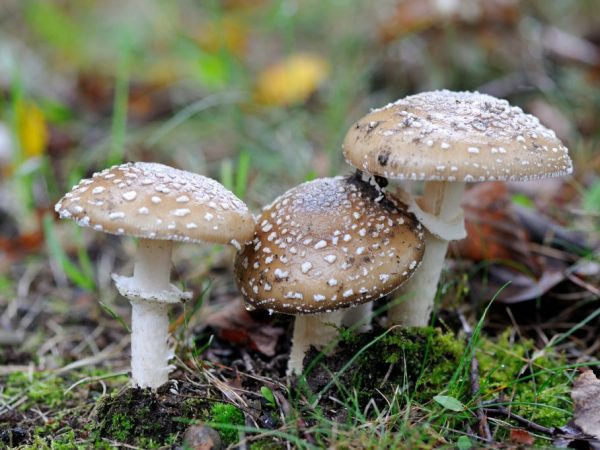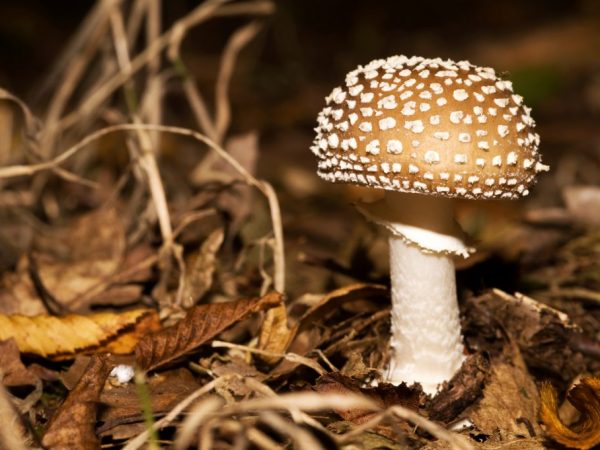Description of panther fly agaric
Amanita muscaria is also called leopard, and all thanks to its appearance. This mushroom is poisonous and has hallucinogenic properties, forms mycorrhiza with different species of coniferous and deciduous trees, but prefers oak and pine. Fruit bodies appear from July to October.

Description Amanita panther
Description of appearance
Externally, it is clearly seen that representatives of this species have gray-brown caps, up to 12 cm in diameter. Initially, the cap is round, later it is leveled, a well-defined tubercle appears in the central part, scars are noticeable along the edges - traces of attachment of the plates. The skin is sticky, white warts are present.
Irina Selyutina (Biologist):
Amanita muscaria is characterized by variations in the color of the cap: brown, black-brown, yellow-brown, etc. White flakes are always present on the cap - the remnants of a common blanket, and its edge is striped due to the white plates of the hymenophore visible through the thin pulp. The leg is usually white, at its base it has a pronounced tuberous expansion covered with an adherent vagina - a volva, which frames this "tuber" and is a ring of scraps arranged in rings. There is a white smooth adherent ring on the surface of the leg.
The alkaloid hyoscyamine was found in the fruit bodies of the Amanita muscaria. Studies have shown that in its structure it is close to atropine.
Did you know? It turned out that hyoscyamine was found in different quantities in different species of representatives of the Solanaceae family (Angiosperms division, Dicotyledonous plants class). Aqueous extract of the panther fly agaric has insecticidal properties.
The pulp is white, has an unpleasant odor, does not change color on the cut. The plates are narrow, free, white. Spores are smooth and elliptical.
The leg is up to 13 cm high, and 0.5-1.5 cm in diameter, hollow, tapers from above, tuberous at the base.
Similar species
There are several types of mushrooms with which it is easy to confuse. For example, gray-pink fly agaric and tall fly agaric.
Distinctive features of gray-pink fly agaric:
- when cut, it changes color (initially, the pulp ceases to be white, becomes pink, and later reaches the color of wine);
- the ring is grooved, striped;
- the cap has no scars along the edges;
- flakes are gray.
This type of the genus Amanita is considered conditionally edible, it requires long-term heat treatment, while it is necessary to drain the water. These species can grow close to each other. Therefore, if a gray-pink fly agaric mushroom was identified, you should not conclude that there are only mushrooms of this species nearby, because a panther fly agaric can also be found a few meters away.
Amanita excеlsa is similar in appearance and description. Amanita mushroom panther differs from it in a leg, tk. in a similar species, it is higher, and in addition, there are no white flakes on the cap.
Beneficial features
Amanita muscaria contains toxic substances, but at the same time it is used for the following medical purposes:
- For the manufacture of medicinal anticancer drugs.
- Tinctures and extracts from fruit bodies of this species are used to relieve pain in joints and bones.
- Used for headaches, as well as for multiple sclerosis.
Contraindications

The fungus can cause severe poisoning
Before using preparations based on amanita muscaria, you should read the information on contraindications.
Amanita muscaria is contraindicated:
- children;
- pregnant and lactating women;
- patients with gastritis or ulcers;
- people who have problems with the pancreas or liver.
In August and September, there is a high probability of poisoning with fly agaric: at this time, there is an active collection of mushrooms, and the last rains can wash away the "insignia" from the hats - the flocculent remnants of a common blanket. When eating even a small amount of fly agaric pulp, after 2 hours, the classic signs of poisoning will appear: fever, dry mucous membranes, nausea, vomiting, problems with swallowing, pupils dilate.
If the poisoning is severe, hallucinations, euphoria, and psychomotor agitation will appear.
At the first symptoms, immediately call an ambulance, and while she is driving you can take the following actions:
- drink salted water, milk or tea to relieve dehydration;
- stimulate vomiting so that poison comes out that was not absorbed into the blood and cleanse the stomach;
- drink activated carbon (1 tab. per 10 kg of mass);
- the victim must be put to bed, since toxic substances interfere with the rhythm of the heart muscle.
Application
This mushroom is not worth eating, because it is poisonous.
Amanita mushrooms are used in official and folk medicine to create drugs. Dark hats, round and flat, are cut lengthwise, dried in the oven at + 50 ° C. If they are large, they need to be dried outdoors. Store in a tightly sealed container in a dark, dry place.
Amanita is used to treat open wounds. To do this, take a hat, knead it into gruel and apply it to the skin with a wound. After about 2 hours, you should be able to see that the affected skin area is starting to tighten.
When using fly agaric, one must remember that it is deadly poisonous. Therefore, all medications are kept far from children, and the containers must be signed so as not to be confused with anything.
The fungus is used not only in medicine, but also for the destruction of harmful insects, for example, flies.
Conclusion
Before going into the forest, you need to carefully study the appearance of edible mushrooms. Be careful, because even a small piece of the mushroom can cause poisoning.



